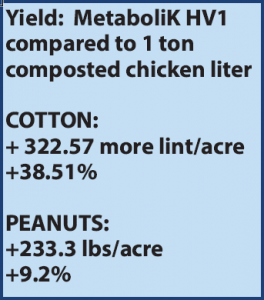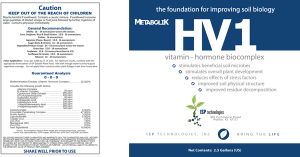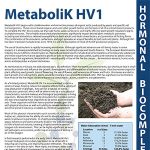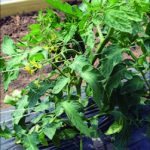MetaboliK HV1 begins with a biofermentation, and extraction process of organic acids produced by yeasts and specific soil microorganisms. These concentrated organic acids and other growth factors are the basis of all of our biostimulant products. To complete the HV1 biocomplex, we than add humic acids; surfactants; and highly effective plant growth regulators (PGRs), or phytohormones. These highly researched phytohormones significantly impact desired plant metabolic processes; including root stimulation, reduced susceptibility to both abiotic and biotic stress factors, and promotion of fruiting forms. This combination of biostimulants, surfactants, and PGRs provides an array of benefits to both soil and plants. Although HV-1 has been improved since 1978, it is still the foundation of most of the ISP production programs.
The use of biostimulants is rapidly increasing world-wide. Although significant advances are still being made, in some respects it is already established technology in many areas including Europe and South America. The European Biostimulants Industry Council defines a biostimulant as, “Agricultural biostimulants include diverse formulations of compounds, substances and micro-organisms that are applied to plants or soils to improve crop vigor, yields, quality and tolerance to abiotic stress.” Based upon the ingredients, MetaboliK HV-1 would qualify in four of the five bio classes … fermentation extracts, humic acids, amino acids/peptides, and plant derivatives.
As mentioned, to this base, we add selected PGRs. By definition, “Plant hormones are not nutrients, but chemicals that in small amounts promote and influence the growth, development, and differentiation of cells and tissues. Plant hormones shape the plant, affecting seed growth, time of flowering, the sex of flowers, and senescence of leaves and fruits. Hormones are vital to plant growth and lacking them, plants would be mostly a mass of undifferentiated cells.” HV1 has significant concentrations from three of the five major classes of hormonal components: auxins, cytokinins and gibberellins.
As a finished product, MetaboliK HV-1 is recommended to aid in a variety of ways, helping reduce the negative effects from a variety of crop production challenges. Any soil has a natural, or native, “production potential”, which will be determined by a soils physical characteristics, nutrient makeup and biological populations, or living organisms. MetaboliK HV-1 directly stimulates the microbial portion of a soil, encouraging these organisms to be active at an increased rate. These organisms will then have a positive benefit upon the soil’s physical structure as well as its ability to release nutrients that are either present naturally or added as a fertilizer supplement.
Much of the physical characteristics such as sand, silt, clay, organic matter, etc., determines the ability of a soil to absorb and retain water, to allow air to penetrate. In a highly productive soil, pore space, (where air and water primarily reside in the soil), can be up to 50% of total soil volume, creating a highly beneficial aerobic (oxygen rich) environment. This can be highly significant, as most soil pathogens are anerobic, preferring an environment lacking in air or free oxygen.
In field research performed in the early 1980’s, MetaboliK HV1, through biological stimulation, has shown to be of benefit in reducing soil crusting, and improving water infiltration. This data is shown in the data at right. More rapid, and deeper, water soak can have a significant improvement in reducing erosion as well as improving a soil’s (and growing crop) to withstand drought conditions.

In other trials where topsoil has been removed or moved during “leveling”, comparing composted chicken liter to HV-1, HV-1 has shown to be as effective, if not more effective, at significantly less cost per acre. (These projects are also described in greater detail in the peanut and cotton research data sections.)
When used in a general broadcast application for general soil improvement, MetaboliK HV-1 is recommended at 12 to 24 fluid ounces per acre on most row crops. It may be applied with liquid fertilizers or plant nutrients, as well as most all pesticide products. It can also be applied as a foliar product on corn or other row crops at rates ranging from 4-16 fluid ounces per acre, depending upon whether or not there was a prior broadcast application.
On produce crops, it is generally recommended at 16 fluid ounces per acre applied broadcast across planting beds, or as part of a transplant solution (although MetaboliK SB is a more standard transplant solution additive). Subsequent applications, at rates of four to six fluid ounces per acre. This has been shown to aid in fruit initiation and fruit set, as well as aiding the plants natural protection mechanisms.
MetaboliK HV-1 is also a useful tool in composting and/or manure management. As a general biostimulant, HV-1 will encourage a more rapid and natural degradation of organic materials. In a composting situation, apply 32 fluid ounces per 100 square yards of material. Turn or mix compost materials on a regular basis.
Benefits:

- stimulates beneficial soil microbes, improving individual soil biome
- large roots, resulting in greater soil volume to provide nutrient
- stimulates overall plant development
- reduces negative effects of abiotic stress factors
- improved soil physical structure and pore space
- improvement in water soak and management
- improved microbial activity leading to improved residue decomposition
- increases yield and improves crop feeding quality





